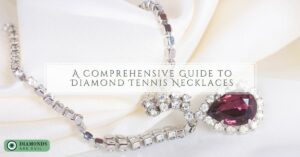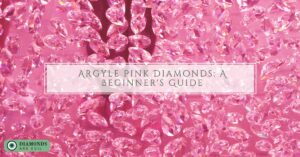The world of fine jewelry is a dazzling one, with diamonds, gems, and pearls as some of its most sought-after treasures. Each gemstone is unique, possessing its own color, clarity, and brilliance. From the classic elegance of a diamond to the vibrant hues of a rare gem, fine jewelry captures the beauty and luxury of the natural world.
From engagement rings and necklaces to bracelets and earrings, fine jewelry holds a special place in our hearts and symbolizes some of life’s most precious moments. So, whether you are a collector, an admirer, or simply curious about this fascinating world, let’s take a closer look at the history, variety, and allure of diamonds, gems, and pearls.
The Appeal of Fine Jewelry
Fine jewelry has been a symbol of elegance and sophistication for centuries. It exudes sheer beauty and perfection that cannot be replicated by any other accessory. The appeal of fine jewelry goes beyond just adornment. They hold sentimental value and are often passed down as heirlooms from generation to generation.
The intricate designs and high-quality materials used in their production make them an investment piece that will last a lifetime. As the saying goes, “diamonds are forever,” and the quality of fine jewelry ensures that they will remain timeless and valuable. From engagement rings to necklaces, bracelets, and earrings. The craftsmanship and exquisite detail of fine jewelry make them truly irresistible.
Diamonds
Diamonds are a mineral composed of pure carbon atoms arranged in a crystal lattice structure. Known for their brilliance and luster, diamonds are versatile and can be used in a variety of industrial and ornamental applications. Most diamonds are formed over millions of years deep beneath the Earth’s surface. Where intense pressure and heat transform carbon molecules into the crystal form we know and love.
Diamonds are graded based on their cut, color, carat weight, and clarity. Diamonds are highly valued for their durability and toughness. This makes them a popular choice for engagement rings and other cherished jewelry pieces.
Where do diamonds come from?
These precious gems are formed deep beneath the Earth’s crust. They are brought closer to the Earth’s surface through volcanic eruptions and then mined. The majority of diamonds come from countries in southern Africa. They can also be found in Australia, Russia, and Canada. The process of diamond mining is meticulous and requires a great deal of skill and expertise.
How are diamonds graded?
Diamonds are one of the most precious and valuable gemstones in the world. Their value is largely determined by their quality. To assess the quality of a diamond, it must go through a grading process that considers several factors.
- Cut Grade: The first step in grading a diamond is to assess its cut, which refers to the diamond’s proportions, symmetry, and polish. The cut determines the diamond’s brilliance, fire, and overall appearance. The cut grade ranges from poor to excellent.
- Color Grade: The next step is to evaluate the diamond’s color. The diamond’s color grade ranges from D (colorless) to Z (yellow). The less color a diamond has, the higher its grade.
- Clarity Grade: The clarity grade evaluates the diamond’s internal and external imperfections, also known as inclusions and blemishes. The clarity grade ranges from Flawless (no imperfections visible under 10x magnification) to Included (imperfections visible to the naked eye).
- Carat Weight: The final step is to determine the diamond’s carat weight, which is the standard unit of measurement for diamonds. One carat is equal to 0.2 grams, and the higher the carat weight, the rarer and more valuable the diamond.
Gems
Gems are natural and beautiful stones that are highly valued for their rarity and physical properties. These precious stones are formed deep inside the earth over a long period of time through various geological processes.
Gems come in a vast array of colors and shapes, from the brilliant sparkle of diamonds to the rich green of emeralds and the deep red of rubies. They are often used in jewelry-making, but also have various uses in technology and industry due to their durability and unique properties.
Where do gemstones come from?
Gemstones are truly one of nature’s wonders. From the deep, rich blues of sapphires to the fiery reds of rubies, these magnificent stones have captivated humans for millennia. But where do gemstones come from?
The answer, quite simply, is that they come from all over the world. Some of the most precious gemstones, such as diamonds, are found deep underground in mines in countries like South Africa, Russia, and Canada. Other gemstones, like amber and turquoise, are formed from the fossilized remains of ancient trees or mineral-rich water.
Different types of gemstones
Gemstones are fascinating natural minerals that are prized for their rarity, beauty, and durability. They come in a variety of colors, shapes, and sizes and have been used for centuries for jewelry, decoration, and healing purposes. In this article, we will explore four different types of gemstones and their unique characteristics.
- Precious Gemstones: The most well-known and valuable gemstones are known as precious gemstones. These include diamonds, emeralds, rubies, and sapphires. Precious gemstones are rare and highly sought-after due to their stunning beauty, exceptional hardness, and durability. They are often used in high-end jewelry pieces and are considered a symbol of luxury and wealth.
- Semi-Precious Gemstones: Semi-precious gemstones are less valuable than precious gemstones but are still highly valued for their unique beauty and properties. This category includes gems such as amethyst, citrine, garnet, and turquoise. Semi-precious gemstones are often used in fashion jewelry and are popular for their vibrant colors and affordability.
- Organic Gemstones: Organic gemstones are formed from living organisms or their remains. These include pearls, amber, and coral. Organic gemstones are highly prized for their unique natural beauty and are often used in high-end jewelry pieces.
- Synthetic Gemstones: Synthetic gemstones are man-made and are created in a laboratory to mimic the natural properties of genuine gemstones. These include cubic zirconia, moissanite, and synthetic diamonds. Synthetic gemstones are often used as more affordable alternatives to natural gemstones and can be just as stunning and durable when crafted with the same care and precision.
Pearls
Pearls are a natural gemstone that are formed inside the shells of certain mollusks. These hard-shelled creatures include oysters and mussels, which are found in both freshwater and saltwater environments. Pearls are created when a foreign object, such as a grain of sand, becomes trapped inside the mollusk’s shell.
The mollusk then coats the object with layers of a material called nacre, which gives the pearl its distinctive iridescent shine. Pearls come in a variety of colors, including white, black, pink, and yellow. They have been prized for their beauty and rarity for thousands of years and are used in jewelry and other decorative items.
Where do pearls come from?
Pearls, coveted for their beauty and elegance, have been treasured since ancient times. These lustrous, iridescent gems are formed in the soft tissue of certain mollusks, including oysters and mussels.
As a protective response to an irritant, the mollusk secretes layers of nacre, a combination of calcium carbonate and organic substances, that harden over time to create a pearl. Natural pearls are incredibly rare and valuable, but they can also be cultivated through a process called pearl farming.
Different types of pearl jewelry
Pearls are a timeless and elegant gemstone that has been used in jewelry for centuries. They are unique in that they are the only gemstone that is created by living creatures. Pearl jewelry comes in a variety of styles, from classic and traditional to modern and trendy.
- Pearl Necklaces: Perhaps the most classic and traditional type of pearl jewelry is the pearl necklace. Pearl necklaces come in a variety of lengths and styles, from a simple single strand of pearls to a more elaborate multi-strand necklace.
- Pearl Earrings: Pearl earrings are a versatile type of pearl jewelry that can be dressed up or down. They come in a variety of styles, from simple pearl studs to more elaborate drop earrings.
- Pearl Bracelets: Pearl bracelets are a beautiful and elegant addition to any jewelry collection. They come in a variety of styles, including classic pearl strands, delicate pearl bangles, and more intricate designs.
- Pearl Rings: Pearl rings are a unique and stunning type of pearl jewelry. They can feature a single pearl or multiple pearls and can be designed with a variety of precious metals and gemstones.
- Pearl Brooches: Pearl brooches are a classic and elegant type of pearl jewelry that can be worn on clothing or as an accessory to a handbag or scarf. They come in a variety of designs, from simple and understated to more elaborate and detailed.
In Conclusion
Throughout history, diamonds, gems, and pearls have been highly sought after for their beauty, rarity, and value. From the time of the ancient Egyptians to modern-day society, fine jewelry has been a symbol of wealth, power, and status. However, the exploration of the world of fine jewelry goes beyond just the monetary value.
Each piece is a work of art, crafted by skilled artisans who have dedicated their lives to perfecting their craft. From the intricate designs to the careful selection of materials, every detail is carefully considered to create the perfect piece of jewelry. So whether you’re looking for a statement piece or something to wear every day, the world of fine jewelry has something to offer everyone.














